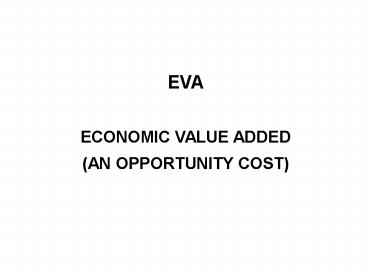Sin t - PowerPoint PPT Presentation
1 / 10
Title:
Sin t
Description:
EVA ECONOMIC VALUE ADDED (AN OPPORTUNITY COST) The calculation of company s cost of capital Cost of debt = risk-free rate + company risk premium Cost of equity (risk ... – PowerPoint PPT presentation
Number of Views:16
Avg rating:3.0/5.0
Title: Sin t
1
EVA ECONOMIC VALUE ADDED (AN OPPORTUNITY COST)
2
- The calculation of companys cost of capital
- Cost of debt risk-free rate company risk
premium - Cost of equity (risk-free rate about 6
equity risk premium) - The equity risk premium is adjusted with the
companys risk level - The risk level of a company depends on the
business risk (business field) - and on the financial risk (solvency)
- A companys cost of capital is calculated as a
weighted average of the above costs of equity and
debt.
3
- The calculation of companys cost of capital
- The cost of capital is calculated with the
target solvency ratio (The cost of capital can
not be decreased simply by increasing leverage
since increasing leverage increases the risk (and
cost) of both equity and debt.) - Debt cost includes tax shield (1- tax rate)
since interest on debt can be deducted from the
taxable revenues
4
- The calculation of companys cost of capital
- Example
- Cost of debt 5,2 1 6,2 (in the long run)
- Cost of equity 5,2 1,2 6 12, 5
- Weighted average cost of capital (WACC) 6, 2
55 (1- tax rate) 12, 5 45 9
5
The calculation of EVA EVA is companys operating
profit (after taxes) subtracted with the total
cost of capital Net operating profit after taxes
Operat. Profit 255 MM 184 MM - - Cost of
capital 9 104 MM WACC x 1190 MM
invested capital EVA 80
MM Or alternatively EVA (ROI - WACC) x
Invested capital (15, 5 - 9,0) x 1190 MM
80 MM
6
- Practice The capital base in calculating EVA
- From the assets side all the items tie capital
and thus all the items should have a cost of WACC - Thus no asset item should be excluded e. g.
because managers cannot affect them - It is important that all the assets are treated
similarly i. e. all the assets have equal cost
(WACC) no matter what their nature is (working
capital, fixed assets etc.)
7
- Practice The capital base in calculating EVA
- However, the capital costs are not as big as WACC
times total assets since company has also non-
interest- bearing debt which do not have any
capital costs - These non- interest- bearing liabilities should
be credited with a revenue item since they
provide the company with capital which would
otherwise have to be acquired from the
alternative sources. Thus these items (accounts
payable, deferred liabilities) should be credited
with WACC - (if we want to be very precise then the
crediting should be only on the level of debt
cost since non- interest bearing liabilities are
debt and increasing them must (in extreme) mean
also increasing equity i. e. you can not
finance all the operations with non- interest
bearing liabilities )
8
- Practice Income statement
- EVA calculation begins with Operating profit
which is deducted with taxes and capital costs in
order to get EVA - Financial incomes can be added to Operating
profit since they are part of normal operations
(and besides cash and bank are with when capital
costs are defined) but usually financial incomes
are so small in industrial companies that they
can be left out - Taxes are calculated simply Operating profit x
tax rate - Taxes are of course not normally so high
because of interest on debt and because of
reserves or execess depreciation but these things
are taken into account elsewhere (tax shield
of interest rates are taken into account in
calculating WACC and taxes on reserves etc. can
be considered as non- interest bearing debt
which do not have any capital costs)
9
- Practice Way of presenting capital costs in
internal income statement (monthly report) - Capital costs from different sources are
practical to present separately so that everyone
can see the effects of different things - The capital cost can be divided e. g. in a
following manner - - Costs of sales receivables
- - Costs of material inventories and WIP
- - Costs of finished goods inventory
- - Costs of fixed assets
- - Costs of other capital items
- - Credit from non- interest- bearing
liabilities () - Of course the breakdown of capital costs changes
from company to company since not all items are
important in all companies
10
Practice Operative (internal reporting) with and
without EVA Internal monthly profit report might
look like this With EVA Without
EVA Turnover 1000 Turnover 1000 -
variable costs 400 - variable costs 400 Gross
margin 600 Gross margin 600 - fixed costs
200 - fixed costs 200 Net margin 400 Net
margin 400 -depreciation 100 -depreciation
100 Operating Profit 300 Operating Profit
300 - taxes from OP 100 Net
operating profit after taxes 200 -Costs of
working capital 50 -Costs of fixed assets
75 Credit of non- interest bearing debt
25 Key ratios Return on capital employed
30 EVA 100

